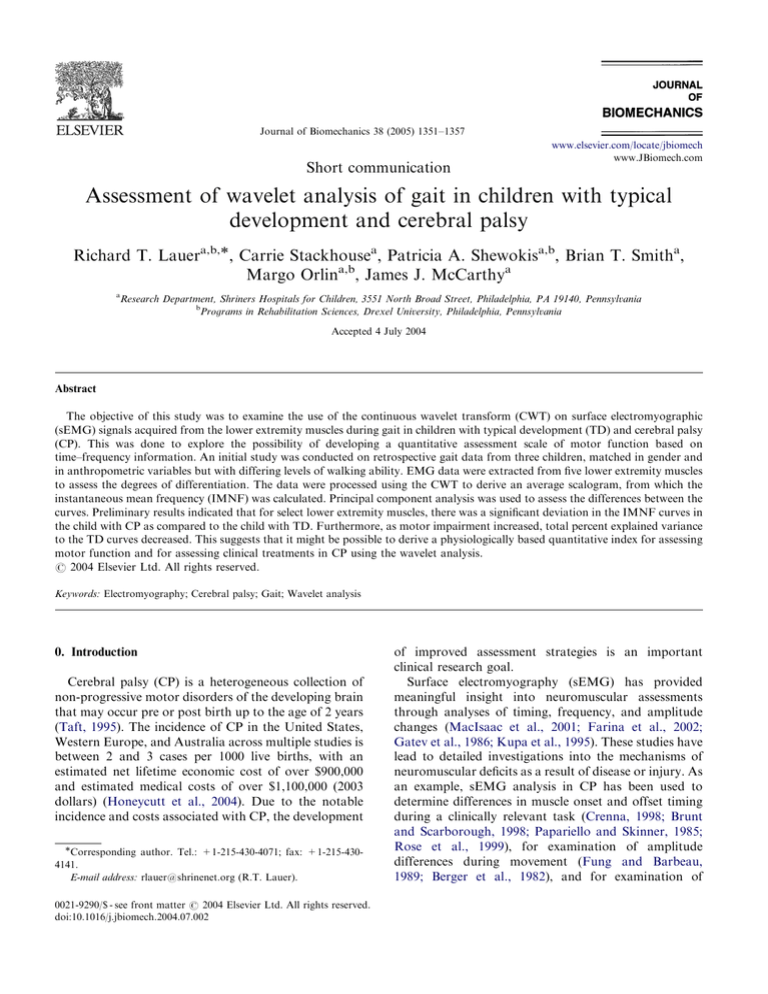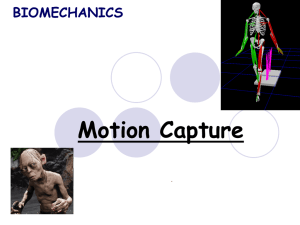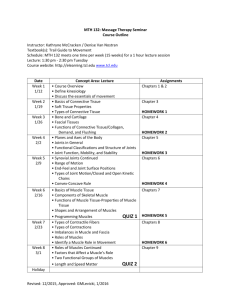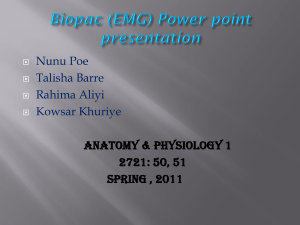
ARTICLE IN PRESS
Journal of Biomechanics 38 (2005) 1351–1357
Short communication
www.elsevier.com/locate/jbiomech
www.JBiomech.com
Assessment of wavelet analysis of gait in children with typical
development and cerebral palsy
Richard T. Lauera,b,, Carrie Stackhousea, Patricia A. Shewokisa,b, Brian T. Smitha,
Margo Orlina,b, James J. McCarthya
a
Research Department, Shriners Hospitals for Children, 3551 North Broad Street, Philadelphia, PA 19140, Pennsylvania
b
Programs in Rehabilitation Sciences, Drexel University, Philadelphia, Pennsylvania
Accepted 4 July 2004
Abstract
The objective of this study was to examine the use of the continuous wavelet transform (CWT) on surface electromyographic
(sEMG) signals acquired from the lower extremity muscles during gait in children with typical development (TD) and cerebral palsy
(CP). This was done to explore the possibility of developing a quantitative assessment scale of motor function based on
time–frequency information. An initial study was conducted on retrospective gait data from three children, matched in gender and
in anthropometric variables but with differing levels of walking ability. EMG data were extracted from five lower extremity muscles
to assess the degrees of differentiation. The data were processed using the CWT to derive an average scalogram, from which the
instantaneous mean frequency (IMNF) was calculated. Principal component analysis was used to assess the differences between the
curves. Preliminary results indicated that for select lower extremity muscles, there was a significant deviation in the IMNF curves in
the child with CP as compared to the child with TD. Furthermore, as motor impairment increased, total percent explained variance
to the TD curves decreased. This suggests that it might be possible to derive a physiologically based quantitative index for assessing
motor function and for assessing clinical treatments in CP using the wavelet analysis.
r 2004 Elsevier Ltd. All rights reserved.
Keywords: Electromyography; Cerebral palsy; Gait; Wavelet analysis
0. Introduction
Cerebral palsy (CP) is a heterogeneous collection of
non-progressive motor disorders of the developing brain
that may occur pre or post birth up to the age of 2 years
(Taft, 1995). The incidence of CP in the United States,
Western Europe, and Australia across multiple studies is
between 2 and 3 cases per 1000 live births, with an
estimated net lifetime economic cost of over $900,000
and estimated medical costs of over $1,100,000 (2003
dollars) (Honeycutt et al., 2004). Due to the notable
incidence and costs associated with CP, the development
Corresponding author. Tel.: +1-215-430-4071; fax: +1-215-4304141.
E-mail address: rlauer@shrinenet.org (R.T. Lauer).
0021-9290/$ - see front matter r 2004 Elsevier Ltd. All rights reserved.
doi:10.1016/j.jbiomech.2004.07.002
of improved assessment strategies is an important
clinical research goal.
Surface electromyography (sEMG) has provided
meaningful insight into neuromuscular assessments
through analyses of timing, frequency, and amplitude
changes (MacIsaac et al., 2001; Farina et al., 2002;
Gatev et al., 1986; Kupa et al., 1995). These studies have
lead to detailed investigations into the mechanisms of
neuromuscular deficits as a result of disease or injury. As
an example, sEMG analysis in CP has been used to
determine differences in muscle onset and offset timing
during a clinically relevant task (Crenna, 1998; Brunt
and Scarborough, 1998; Papariello and Skinner, 1985;
Rose et al., 1999), for examination of amplitude
differences during movement (Fung and Barbeau,
1989; Berger et al., 1982), and for examination of
ARTICLE IN PRESS
1352
R.T. Lauer et al. / Journal of Biomechanics 38 (2005) 1351–1357
analysis could be used to derive a quantitative scale for
classifying neuromuscular differences among children
with typical development (TD) and children with CP
which could also be used to provide a quantitative
measure of the outcome of a clinical intervention. The
initial step was to test the hypothesis that the
instantaneous mean frequency (IMNF) curves from
various lower extremity muscles, derived from the CWT,
are different between children with TD and CP, and that
the curves deviated significantly from normal with
increasing severity of the motor impairment. This
analysis was performed with retrospective data on a
small sample size to investigate whether a larger scale
study is warranted.
differences in muscle frequency content (Yoshida et al.,
2003; Sgouros and Seri, 2002).
The shortcoming of these studies, however, has been
that only one aspect of the sEMG signal is examined in
isolation, which has been stated to be of limited value
clinically (Roetenberg et al., 2003). A method that could
combine the analysis of several sEMG characteristics
simultaneously could potentially be of value. Furthermore, if the results from this method could be developed
into a quantitative assessment scale of motor function,
which has been done with sEMG onset and offset timing
(Burridge et al., 2001; Fung and Barbeau, 1989), and
with sEMG magnitude (Lee et al., 2004), it may prove to
be a useful aid in CP diagnosis and in assessment of the
effectiveness of clinical interventions.
The use of the wavelet transform, whether continuous
(CWT) or discrete (DWT) has been proposed as a
method for providing a time–frequency analysis of
sEMG. Recent studies have shown the potential of
using the CWT for frequency analysis of muscle
activation during isokinetic assessments (Karlsson et
al., 2003; 2001), cycling (von Tscharner, 2002), and gait
(von Tscharner et al., 2003; von Tscharner and
Goepfert, 2003) in able bodied adults. Further, the
CWT has also been used in adults with Parkinsons to
derive a quantitative scale of the severity of neurologic
impairment in the upper extremity (De Michele et al.,
2003), and for EMG timing assessments during gait
(Merlo et al., 2003), which indicates that this analysis
may be applicable to CP.
An index, based upon the CWT analysis, may provide
physiologically meaningful information that can be a
valuable adjunct to subjective classifications of function
and self-reported scores of impairment currently utilized
for clinical assessment in CP (Palisano et al., 1997;
Daltroy et al., 1998; Novacheck et al., 2000). Additionally, CWT may be able to provide an index of
neuromuscular function during ambulation to complement quantitative assessments of mechanical function
during gait such as joint angular kinematics and kinetics
(DeLuca et al., 1997; Gage, 1993; Schutte et al., 2000).
The objective of this study was to assess the possibility
of applying CWT techniques to analyze gait in children
with CP, and to determine if this method of sEMG
1. Methods
A retrospective study was conducted with three
children who underwent gait analysis. All analyses were
performed as the subjects walked at a self-selected speed
across a 28 foot walkway. A university affiliated IRB
granted exempt status for use of this data given the fact
that the data had already been collected, no additional
data would be collected, and that the identity of the
individuals remained anonymous. The three subjects
were matched according to body mass ð27:2 2:7 kgÞ;
height ð132:4 2:4 cmÞ; leg length ð69:8 1:2 cmÞ; and
gender (female) to remove these factors as potential
confounds and sources of variation. However, all
subjects differed in their walking ability based upon
temporal-spatial parameters (Table 1). One subject was
of typical development (TD); the second subject was
diagnosed with right, spastic hemiplegia (SH); the third
subject was diagnosed with spastic diplegia (SD).
The EMG signals were recorded from the following
muscles bilaterally: the rectus femoris (RF), the vastus
lateralis (VL), the medial gastrocnemius (MG), the
medial hamstrings (MH), and the tibialis anterior (TA).
The EMG data were acquired using Motion Lab
Systems MA-310 surface EMG recording system (Motion Lab Systems, Baton Rouge LA, USA). For each
electrode, the area was cleaned beforehand with alcohol,
and the electrode was secured in place using both tape
Table 1
Temporal-spatial gait parameters for the three subjects examined in this study
Typical
Spastic Hemiplegia (Right)
Spastic Diplegia
Step length (m)
Cadence (steps/min)
Velocity (m/s)
GMFCS level
0.54
0.43
0.43
129
135
103
1.19
1.04
0.77
N/A
I
III
Also included in the table is the Gross Motor Function Classification Score (GMFCS) for the subjects with CP. GMFCS Level I indicates an ability
to walk with restrictions, but there are limitations in performing more advanced motor skills. GMFCS III indicates the use of an assistive device for
ambulation and that there are limitations when walking outdoors or in the community. No score (N/A) is assigned to the child with typical
development.
ARTICLE IN PRESS
R.T. Lauer et al. / Journal of Biomechanics 38 (2005) 1351–1357
and a non-adhesive wrap. The placement of each
electrode was in the area of greatest cross sectional
area, in a direction that was parallel to the muscle fibers.
For the RF, this was one-half the distance along a line
from the anterior superior iliac spine (ASIS) to the
middle of the superior aspect of the patella. VL
placement was one-quarter the distance along a line
from the fibular head to the ASIS. The placement for the
TA was one-third the distance from the lower margin of
the patella to the lateral calcaneus. The SM electrode
was located midway along a line from the ischial
tuberosity and the medial condyle of the tibia, while
the MG electrode was located one-third the distance
from the medial femoral condyle to the bisection of the
posterior aspect of the calcaneus.
All signals were pre-amplified with a gain of 20 and
bandwidth filtered from zero to 2000 Hz. The preamplifiers were connected to a patient-worn backpack unit
that provided additional bandwidth filtering from 20 to
2000 Hz and anti-alias filtering with a cut-off of 350 Hz.
The pack also provided an amplitude turn dial that was
adjusted based on the voltage output of a maximal
volitional effort from the muscle to give a maximum
gain within the specifications of the analog-to-digital
converters (rails are þ= 2:5 VDC) used. All EMG
signals were sampled at 1200 Hz.
Data analysis was performed using MATLAB
(The MathWorks Inc., Natick MA, USA) and the
Time-Frequency Toolbox (Auger et al., 1996). For
each subject, the first three trials were analyzed, and
the first 10 gait cycles (heel strike to heel strike) for the
right side and for the left side were extracted from
the EMG data using the time-synchronized marker
data collected with the Vicon 370 system (Vicon
Motion systems, Lake Forest CA, USA). This was
done to minimize the effects of fatigue on the data.
All EMG signals were normalized to 500 points
(representing the gait cycle from 0% to 100% in 0.2%
increments). A root mean squared (RMS) algorithm
(Laughton et al., 2003) was employed to determine
EMG onset and offset times from the averaged EMG.
This was done to verify that the CWT analysis preserved
the timing information.
The CWT calculated for each individual EMG signal
is defined as follows (Torrence and Compo, 1997):
Z 1
CWTx ðs; tÞ ¼
xðtÞcs;t ðtÞ dt
ð1Þ
1353
(Torrence and Compo, 1997):
c0 ðZÞ ¼ p0:25 eio0 Z eZ
2
=2
ð2Þ
where Z represents a nondimensional time parameter
and o0 is the nondimensional frequency, which was
taken to be six to satisfy the admissibility condition of a
zero mean and localization in both the time and
frequency space. The Morlet was selected for use, with
a linear scale of 1–126, based upon previous CWT
analyses using sEMG (Karlsson et al., 2001; Flanders,
2002.). However, the exact selection of the wavelet
function was not critical given that we were interested in
the wavelet power spectrum, and each function gives
approximately the same qualitative results (Torrence
and Compo, 1997).
The scalogram, representing the squared magnitude
of the CWT, was calculated for each sample of each
EMG signal. The 10 scalograms for each muscle for
each side were averaged to derive a representative
time–frequency pattern, and a representative value of
the spectrum at each gait interval was calculated using
the IMNF (Karlsson et al., 2003, 2001) derived from the
following equation:
Z
Z
IMNFðtÞ ¼ f Pðt; f Þ df
Pðt; f Þ df
ð3Þ
where Pðt; f Þ represents the scalogram at each interval of
the gait cycle and f represents the frequency range of the
EMG signal from zero to the Nyquist frequency (500 Hz
after normalization). The calculation of the mean
frequency representation of the scalogram was selected
based upon results achieved with IMMF calculations
using the short time Fourier Transform (STFT) (Potvin
and Bent, 1997) in detecting subtle changes in muscle
fatigue during dynamic motions.
The analysis of the data involved comparison of the
right and left side on the averaged IMNF curves from
each of the five tested muscles in the child with TD, and
comparison for each of the five tested muscles between
TD and SH and between TD and SD. Principal
component analyses were conducted and the percent
total variance explained by the first factor from each
comparison were determined (Ramsay and Silverman,
1997). All analyses were performed using Statistica
(Statsoft, Inc., Tulsa OK, USA).
1
where xðtÞ represents the EMG signal as a function of
time, c represents the mother wavelet, s is the scale, t
represents the shifting parameter, and the (*) indicates
the complex conjugate. The CWT was employed for this
analysis because of its ability to provide the most
information and detail to detect changes within the
sEMG signal (Hostens et al., 2004). The prototype
wavelet used was the Morlet wavelet defined as
2. Results
The IMNF plots for the ten muscles in each subject
are represented in Fig. 1 (left side) and 2 (right side). For
each muscle, the average IMNF curves (solid line) with
one standard deviation (gray lines) are shown. Also
shown are the muscle onset (solid vertical) and offset
times (dashed vertical), as determined from the RMS
ARTICLE IN PRESS
1354
R.T. Lauer et al. / Journal of Biomechanics 38 (2005) 1351–1357
Fig. 1. Instantaneous mean frequency (IMNF) curves generated for the five lower extremity muscles on the left side in the three children studied.
Highlighted in each graph is the occurrence of EMG onset (solid vertical line) and the EMG offset (dashed vertical line) as determined using a root
mean squared (RMS) algorithm.
method. Preservation of EMG onset and offset timing,
as calculated with the RMS, is preserved in the IMNF
data.
Principal component analysis of the IMNF curves
indicated a high explained variance between the right
and left sides for the subject with TD (Table 2) with
values greater than 97% for all muscles. Comparisons
made for each muscle between the child with TD and
SD indicated a decreased explained variance bilaterally.
This effect was strongest for the TA and RF muscles,
and greater for the left side than the right. Explained
variance between the IMNF curves between the subject
with TD and the subject with SH were also lower, but
not as low as compared to the child with SD. The more
involved side (right side) demonstrated on average a
lower explained variance across the TA, MG and RF
muscles. Values were well above 90% for the MH and
VL muscles. The less affected side (left) also demonstrated decreased explained variance for the TA and RF
muscles, but high (above 90%) explained variances for
the other three muscles.
3. Discussion
The objective of this study was to assess the possibility
of applying CWT techniques to analyze sEMG during
gait in children with CP, and to determine if this method
of analysis could be used as a basis for a quantitative
assessment scale of classifying neuromuscular differences in children with CP. As an initial step towards the
development of the scale, it was necessary to determine
if significant differences could be determined between
children with TD and children with CP given the
variability that exists in surface EMG data, and if
differences between different levels of motor function in
the child with CP would be reflected in the CWT
analysis.
The results of this preliminary investigation indicated
that the use of the IMNF as a representation of
time–frequency information can potentially be used to
assess the degree of motor impairment in CP. The results
of the principal component analysis of the IMNF curves
for the right and left sides in the child with TD suggests
ARTICLE IN PRESS
R.T. Lauer et al. / Journal of Biomechanics 38 (2005) 1351–1357
1355
Fig. 2. Instantaneous mean frequency (IMNF) curves generated for the five lower extremity muscles on the right side in the three children studied.
Highlighted in each graph is the occurrence of EMG onset (solid vertical line) and the EMG offset (dashed vertical line) as determined using a root
mean squared (RMS) algorithm.
Table 2
Total percent (%) variance explained by the first principal component
factor between the right and left sides for each muscle for the subject
with TD, for each muscle on the right and left side between the subject
with TD and the subject with SD, and for each muscle on the right and
left side between the subject with TD and the subject with SH
Classification
Side(s)
TD
TD-SD
TD-SD
TD-SH
TD-SH
R vs L
R
L
R
L
TA
97.60
63.87
57.46
66.26
74.36
MG
99.44
81.20
76.76
75.66
97.84
MH
97.47
84.17
74.72
94.74
93.67
VL
99.90
80.01
70.92
97.20
97.54
RF
99.00
65.60
61.10
60.28
65.93
that inter subject variability between children with TD
can be expected to be low even with the high variability
of the sEMG. Comparison of the right and left sides,
where no difference would be expected, demonstrated a
very high percentage of the variance being explained
with one factor. These results would indicate that a drop
in the percent variance would be a good indication of
which muscles are affected in the child with CP, and to
what degree.
This concept was further supported using the data for
the two subjects with CP. The child with SH demonstrated a high total percent explained variance for the
more proximal muscles (VL, MH, RF), and a decrease
in percent variance in the more distal (TA, MG). This
agrees with the diagnosis of right foot drop in this
subject. The decreases in percent variance explained on
the left, less involved side, for the TA and RF are also in
agreement with the clinical understanding that the
‘‘uninvolved’’ side in the child with SH is in fact ‘‘less
involved’’ (Gordon et al., 1999). Total percent explained
variances dropped for all muscles for the child with SD
on average compared to the child with SH and TD, were
higher for the more distal than the proximal muscles
within this subject, and were greater on the left than the
right side. This drop in total percent variance is expected
given the decreases in the temporal-spatial parameters
(Table 1), and indicated a potential of scaling motor
involvement using the IMNF.
ARTICLE IN PRESS
1356
R.T. Lauer et al. / Journal of Biomechanics 38 (2005) 1351–1357
There are several factors may have contributed for this
reduction in percent variance explained in the children
with CP compared to the child with TD, including
changes in muscle fiber composition (Rose et al., 1994),
inability to recruit muscles fully (Banks et al., 2003),
muscle coactivation (Rose et al., 1999), and muscle
cocontraction (Ikea et al., 1998; Damiano et al., 2000).
Using the small test sample presented in this study, it is
not possible to predict whether the CWT analysis can be
used to distinguish between these factors, but will be
assessed through further investigation.
The decrease in percent variance explained in the
IMNF curves of the children with CP as the level of
motor function diminishes would indicate that a
quantitative assessment scale would be feasible to
develop using this data. The exact nature of the scale
is unknown at this time and would require a larger
database for development. However, the use of the
IMNF in this scale is ideal because of the incorporation
of EMG onset and offset timing into a measure of
muscle recruitment as reflected in the frequency
information. Given that EMG onset and amplitude
have already been proven to be useful in CP diagnosis
(Crenna, 1998; Berger et al., 1982; Brunt and Scarborough, 1998; Papariello and Skinner, 1985; Rose et al.,
1999), the combination of these factors can potentially
provide a quantitative, objective scale to reporting the
degree of motor impairment that may not be detectible
using the current subjective and self-reported scales.
Future studies will include using the CWT to understand and quantify the outcomes of a clinical intervention, such as the use of functional electrical stimulation
for the correction of foot drop or Botulinum toxin
injections for spasticity, and potentially identify those
children with CP who respond well to certain types of
interventions. Furthermore, the use of this particular
quantitative scale for the assessment of motor function
can potentially provide further insight into the neuromuscular mechanisms related to CP, which is a
limitation of current quantitative assessments based
upon joint kinematics and kinetics.
Acknowledgements
Funding for this study was provided by Shriners
Hospitals for Children, Grant #8530. The authors also
wish to thank the Motion Analysis Laboratory at the
Shriners Hospitals Philadelphia Unit for performing the
data collection.
References
Auger, F., Flandrin, P., Gonclaves, P., Lemoine, O., 1996. Time–Frequency Toolbox—For use with MATLAB. Centre National de
la Rechereche Scientifique, France.
Banks, K., Gieringer, R., Musket, M., Stackhouse, S., Eastlack, M.,
Lee, S., 2003. Comparison of stimulation patterns used to assess
voluntary muscle activation of the quadriceps femoris. In:
Proceedings of the Combined Sections Meeting of the American
Physical Therapy Association. Tampa, FL.
Berger, W., Quintern, J., Dietz, V., 1982. Pathophysiology of gait in
children with cerebral palsy. Electroencephalography and Clinical
Neurophysiology 53, 538–548.
Brunt, D., Scarborough, N., 1998. Ankle muscle activity during gait in
children with cerebral palsy and equinovarus deformity. Archives
of Physical Medicine and Rehabilitation 69, 115–117.
Burridge, J., Wood, D., Taylor, P., McLellan, D., 2001. Indices to
describe different muscle activation patterns, identified during
treadmill walking in people with spastic drop-foot. Medical
Engineering and Physics 23, 427–434.
Crenna, P., 1998. Spasticity and ‘Spastic’ gait in children with
cerebral palsy. Neuroscience and Biobehavioral Reviews 22,
571–578.
Daltroy, L., Liang, M., Fossel, A., Goldberg, M., 1998. The POSNA
pediatric musculoskeletal functional health questionnaire: report
on the reliability, validity, and sensitivity to change. Journal of
Pediatric Orthopaedics 18, 561–571.
Damiano, D., Martellotta, T., Sullivan, D., Granata, K., Abel, M.,
2000. Muscle force production and functional performance in
spastic cerebral palsy: relationship of cocontraction. Archives of
Physical Medicine and Rehabilitation 81, 895–900.
DeLuca, P., Davis, R., Ounpuu, S., Rose, S., Sirkin, R., 1997.
Alterations in surgical decision making in patients with cerebral
palsy based on a three dimensional gait analysis. Journal of
Pediatric Orthopaedics 17, 608–614.
De Michele, G., Sello, S., Carboncini, M., Rossi, B., Strambi, S., 2003.
Cross-correlation time-frequency analysis for multiple EMG
signals in Parkinson’s disease: a wavelet approach. Medical
Engineering and Physics 25, 361–369.
Farina, D., Fosci, M., Merletti, R., 2002. Motor unit recruitment
strategies investigated by surface EMG variables. Journal of
Applied Physiology 92, 235–247.
Flanders, M., 2002. Choosing a wavelet for single-trial EMG. Journal
of Neuroscience Methods 116, 165–177.
Fung, J., Barbeau, H., 1989. A dynamic EMG profile index to quantify
muscular activation disorder in spastic paretic gait. Electroencephalography and clinical Neurophysiology 73, 233–244.
Gage, J.R., 1993. Gait analysis: an essential tool in the treatment of
cerebral palsy. Clinical Orthopaedics 288, 126–134.
Gatev, P., Ivanova, T., Gantchev, G., 1986. Changes in the firing
pattern of high-threshold motor units due to fatigue. Electromyography and Clinical Neurophysiology 26, 83–93.
Gordon, A., Charles, J., Duff, S., 1999. Finertip forces during object
manipulation in children with hemiplegic cerebral palsy. II:
bilateral coordination. Developmental Medicine and Child Neurology 41 (3), 176–185.
Honeycutt, A., Dunlap, L., Chen, H., al Homsi, G., 2004. Economic
costs associated with mental retardation, cerebral palsy, hearing
loss, and vision impairment—United States, 2003. MMWR Weekly
53 (03), 57–59.
Hostens, I., Seghers, J., Spaepen, A., Ramon, H., 2004. Validation of
the wavelet spectral estimation technique in Bicep Brachii and
Brachioradialis fatigue assessment during prolonged low-level
static and dynamic contractions. Journal of Electromyography
and Kinesiology 14, 205–215.
Ikea, A., Abel, M., Granata, K., Damiano, D., 1998. Quantification of
cocontraction in spastic cerebral palsy. Electromyography and
Clinical Neurophysiology 38, 497–504.
Karlsson, J., Gerdle, B., Akay, M., 2001. Analyzing surface myoelectric signals recorded during isokinetic contractions. IEEE
Engineering in Medicine and Biology 20, 97–105.
ARTICLE IN PRESS
R.T. Lauer et al. / Journal of Biomechanics 38 (2005) 1351–1357
Karlsson, J., Ostlund, N., Larsson, B., Gerdle, B., 2003. An estimation
of the influence of force decrease on the mean power spectral
frequency shift of the EMG during repetitive maximum dynamic
knee extensions. Journal of Electromyography and Kinesiology 13,
461–468.
Kupa, E.J., Roy, S.H., Kandarian, S.C., De Luca, C.J., 1995. Effects
of muscle fiber type and size on EMG median frequency and
conduction velocity. Journal of Applied Physiology 79, 23–32.
Laughton, C., Slavin, M., Katdare, K., Nolan, L., Bean, J., Kerrigan,
D., Phillips, E., Lipsitz, L., Collins, J., 2003. Aging, muscle activity,
and balance control: physiologic changes associated with balance
impairment. Gait and Posture 18, 101–108.
Lee, D., Lim, H., McKay, W., Priebe, M., Holmes, S., Sherwood, A.,
2004. Toward an objective interpretation of surface EMG patterns:
a voluntary response index (VRI). Journal of Electromyography
and Kinesiology 14, 379–388.
MacIsaac, D., Parker, P., Scott, R., Englehart, K., Duffley, C., 2001.
Influences of dynamic factors on myoelectric parameters. IEEE
Engineering in Medicine and Biology 20, 82–89.
Merlo, A., Farina, D., Merletti, R., 2003. A fast and reliable
technique for muscle activity detection from surface EMG
signals. IEEE Transactions on Biomedical Engineering 50 (3),
344–353.
Novacheck, T., Stout, J., Tervo, R., 2000. Reliability and validity of
the Gillette functional assessment questionnaire as an outcome
measure in children with walking disabilities. Journal of Pediatric
Orthopaedics 20, 75–81.
Palisano, R., Rosenbaum, P., Walter, S., Russell, D., Wood, E.,
Galuppi, B., 1997. Development and reliability of a system to
classify gross motor function in children with cerebral palsy.
Developmental Medicine and Child Neurology 39 (4), 214–223.
Papariello, S., Skinner, S., 1985. Dynamic electromyography analysis
of habitual toewalkers. Journal of Pediatric Orthopedics 5,
171–175.
Potvin, J., Bent, L., 1997. A validation of techniques using surface
EMG signals from dynamic contractions to quantify muscle fatigue
during repetitive tasks. Journal of Electromyography and Kinesiology 7, 131–139.
1357
Ramsay, J., Silverman, B., 1997. Principal components analysis for
functional data. In: Functional Data Analysis. Springer, New
York, pp. 85–110.
Roetenberg, D., Buurke, J., Veltink, P., Cordero, A., Hermens, H.,
2003. Surface electromyography analysis for variable gait. Gait and
Posture 18, 109–117.
Rose, J., Haskell, W., Gamble, J., Hamilton, R., Brown, D., Rinsky,
L., 1994. Muscle pathology and clinical measures of disability in
children with cerebral palsy. Journal of Orthopaedic Research 12,
758–768.
Rose, J., Martin, J., Torburn, L., Rinsky, L., Gamble, J., 1999.
Electromyographic differentiation of diplegic cerebral palsy from
idiopathic toe walking: involuntary coactivation of the quadriceps
and gastrocnemius. Journal of Pediatric Orthopedics 19, 667–677.
Schutte, L., Narayanan, U., Stout, J., Selber, P., Gage, J., Schwartz,
M., 2000. An index for quantifying deviations from normal gait.
Gait and Posture 11, 25–31.
Sgouros, S., Seri, S., 2002. The effect of intrathecal baclofen on muscle
co-contraction in children with spasticity of cerebral origin.
Periatric Neurosurgery 37, 225–230.
Taft, L., 1995. Cerebral palsy. Pediatrics in Review 16, 411–418.
Torrence, C., Compo, G., 1997. A practical guide to wavelet analysis.
Bulletin of the American Meterological Society 79 (1), 61–78.
von Tscharner, V., 2002. Time-frequency and principal-component
methods for the analysis of EMGs recorded during a mildly
fatiguing exercise on a cycle ergometer. Journal of Electromyography and Kinesiology 12, 479–492.
von Tscharner, V., Goepfert, B., 2003. Gender dependent EMGs of
runners resolved by time/frequency and principal pattern analysis.
Journal of Electromyography and Kinesiology 13, 253–272.
von Tscharner, V., Goepfert, B., Nigg, B., 2003. Changes in EMG
signals for the muscle tibialis anterior while running barefoot or
with shoes resolved by non-linearly scaled wavelets. Journal of
Biomechanics 36, 1169–1176.
Yoshida, M., Nakajima, I., Uchida, A., Yamaguchi, T., Akasaka, M.,
2003. Effect of nitrous oxide on dental patients with cerebral
palsy—using an electromyogram (EMG) from orofacial muscles as
an index. Journal of Oral Rehabilitation 30, 324–333.








